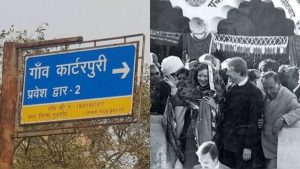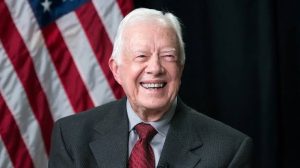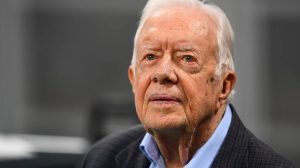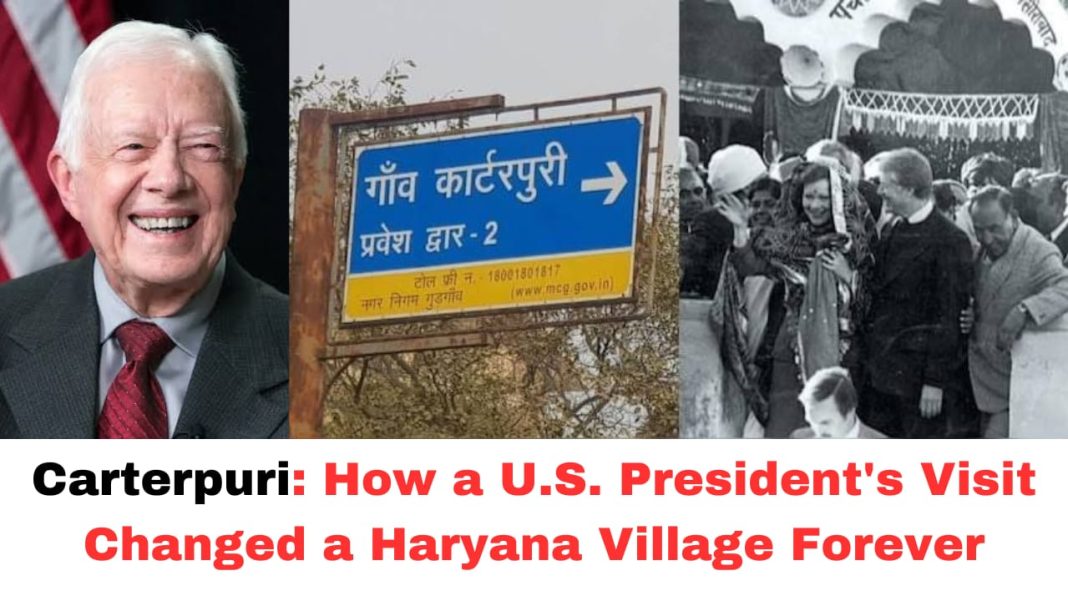Digital News Guru Haryana Desk:
From Daulatpur Nasirabad to Carterpuri: The Story of a Village Named After a U.S. President
Among the vast number of historical and cultural connections that link India with the United States, the story of a small village in Haryana named ‘Carterpuri’ stands out. This village, located near the bustling metropolis of Gurgaon (now Gurugram), has a unique claim to fame — it is named after the former U.S. President Jimmy Carter. The village’s association with the former president is not just a matter of name but also a powerful example of the deep ties that can form between individuals and communities, transcending international borders. This article explores the origins of Carterpuri and the lasting impact of Jimmy Carter on the village and its people.
The Origins of Carterpuri
The story of Carterpuri begins in the late 1970s, a time when Jimmy Carter, an advocate for peace and human rights, was President of the United States. In January 1978, Carter visited India, and during his visit, he spent time in a rural village in Haryana, which was then known as Daulatpur Nasirabad. This visit was significant not just because it marked the coming together of two nations but also because it was a moment of profound personal connection between Carter and the local community.

During his trip, Carter was accompanied by his wife, Rosalynn, and their children, as well as Haryana’s Chief Minister at the time, Devi Lal. The visit was made even more special by the presence of Carter’s mother, Lillian Carter, who had served as a volunteer with the Peace Corps in India in the late 1960s. Lillian’s experience in India had left a lasting impression on her and provided the perfect context for her son’s visit to the country.
In an act of generosity, President Carter donated money and a television set to the village during his visit. However, it was the gesture of naming the village after him that turned out to be the most lasting tribute. As a token of gratitude for the president’s visit and the association with his mother’s Peace Corps work in the region, the residents of Daulatpur Nasirabad decided to rename the village ‘Carterpuri.’ This was a rare and meaningful act, which saw a community recognizing the significance of an international figure in their lives by immortalizing his name in the very heart of their village.
The Legacy of Jimmy Carter in Carterpuri
Since the renaming of Daulatpur Nasirabad to Carterpuri, the village has maintained a special connection with the United States, and particularly with Jimmy Carter. The village has continued to commemorate the date of Carter’s visit each year, on January 3rd, through various local events. These commemorations serve not only as a reminder of Carter’s visit but also as a celebration of the bond between the United States and India, and of the enduring friendship between Jimmy Carter and the people of Carterpuri.
Moreover, the villagers have taken great pride in their unique connection to the former U.S. president. Over the years, the residents of Carterpuri maintained regular correspondence with the White House during Carter’s presidency, reinforcing the ties between the village and the American government. While the day-to-day life in the village may have changed over the years, the memory of Carter’s visit remains an integral part of the local culture and heritage.

The Role of Lillian Carter and Peace Corps
The story of Carterpuri is also deeply intertwined with the role of Lillian Carter, Jimmy Carter’s mother, who served as a Peace Corps volunteer in India in the late 1960s. Her work in the country, especially in the rural areas of Haryana, had a profound impact on the local communities. Lillian was involved in promoting health care, hygiene, and education, and she quickly became beloved by the people she served. Her contribution was recognized by the villagers, many of whom were moved by her selflessness and dedication to their well-being.
Lillian Carter’s time in India is an important part of the backstory to Carterpuri’s name. Her connection to the region helped pave the way for the visit of her son, President Jimmy Carter, nearly a decade later. It also set the stage for the strong bond that was formed between the village and the U.S. government. When Jimmy Carter visited Carterpuri in 1978, he was following in his mother’s footsteps, continuing her legacy of service and compassion in a region that had made a deep impression on her.
Modern-Day Challenges in Carterpuri
While Carterpuri is a symbol of friendship and international connection, it is not immune to the challenges of urbanization. Over the decades, the village has faced several issues related to population growth, infrastructure development, and sanitation. Like many rural villages near rapidly growing urban centers, Carterpuri has seen a rise in illegal constructions and a lack of proper sanitation facilities, which have impacted the quality of life for its residents.
However, the community has not been idle in the face of these challenges. Several non-governmental organizations (NGOs) and local initiatives have been working to address these issues. Their efforts focus on sustainable development, improving public health, and ensuring environmental sustainability. These initiatives, often in partnership with local authorities, aim to modernize the village while preserving its unique identity and honoring its connection to Jimmy Carter and his family.
Carterpuri’s Significance Today
Today, Carterpuri stands as a symbol of the enduring friendship between the United States and India. The village’s connection to Jimmy Carter is a testament to the power of personal connections and the lasting impact that one person can have on a community. Beyond its physical location, Carterpuri serves as a reminder of the broader global relationships that can be forged through kindness, generosity, and mutual respect.

For the villagers of Carterpuri, their village’s name is more than just a geographic marker — it is a badge of honor, a celebration of the relationship between their home and one of the most influential leaders of the 20th century. The memory of Jimmy Carter’s visit to the village in 1978, along with the legacy of his mother’s Peace Corps work, continues to resonate in the hearts of the people who call Carterpuri home.
As Carterpuri moves forward into the future, it will likely continue to face the challenges that come with urbanization. However, the village’s deep ties to the legacy of Jimmy Carter offer a unique foundation upon which to build, creating an enduring symbol of international friendship and cooperation.
You May Also Read: Tributes Pour In as Jimmy Carter, 39th U.S. President, Passes Away at 100








